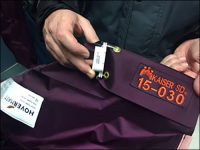
RTLS technology helps solve the problem of hospital air cushion loss
[ad_1]
Prior to the use of the RTLS solution, the HoverMatt transport air cushion at the Zion Medical Center of a San Diego hospital operated by Kaiser Permanente had a very high loss rate. The unit price of the transport air cushion is as high as $2,000, and the monthly loss rate is as high as 8%. By using the battery-powered RTLS label provided by Awarepoint on the air cushion and using Awarepoint’s RTLS software, the hospital not only found the cause of the air cushion loss but also solved the problem of loss.
By using tags on the transport air cushion, the medical center can automatically identify their location and set up an alarm system when the air cushion leaves the site. The investigation found that many missing air cushions were placed in the garbage compressor. After cleaning the air cushions, employees often negligently discard these deflated cushions into the trash can that is about to be transported to the compressor. Kaiser Senior Financial Analyst Andrea Odom said that by understanding and solving the reasons for the loss, the hospital has obtained a return on investment of the Awarepoint label and has begun to purchase more labels to use.

(Zion Medical Center attaches the Awarepoint label to the baffle of the HoverMatt air cushion air nozzle)
The HoverMatt air cushion is an inflatable cushion, and employees can easily lift the air cushion while the patient is lying down. According to Odom, patients are heavier and less convenient to move when they arrive at the hospital than 50 years ago. Therefore, the hospital has purchased lifting equipment to ensure that these patients have less pain when moving (for example, from a stretcher to a bed). . When not in use, the air cushion will deflate, so employees sometimes confuse it with disposable items or sheets. Since hospitals also use disposable transport air cushions (which look similar), it becomes more difficult to identify these high-value air cushions.
Initially, the hospital purchased 500 air cushions in 2013, but only 162 were left at the time of inventory in August 2014. Odom said that the hospital conducted an investigation and talked with EMS employees and employees of the ancillary facilities. However, no one can point out the location of these air cushions.
Zion Medical Center has used the first-generation Awarepoint RTLS technology to track assets such as beds, vacuum assisted wound healing systems, pumps, etc., so they found this RTLS technology provider for negotiation and chose to use tags on the remaining air cushions. When the hospital began labeling in May 2015, the hospital lost another 74 air cushions.
The ZionAwarepoint RTLS solution uses 2.4 GHz RTLS tags, which can send out ZigBee protocol signals and are compatible with the ISO 802.15.4 standard. The sensors distributed in different locations of the hospital will capture the signal of the ZigBee tag and then send the data back to the Awarepoint software through other sensors.
Lee said that Awarepoint’s next-generation RTLS solution uses BLE tags and BLE receivers to transmit location data via WiFi, which can transmit data back to the reader within 1 meter within 2 seconds.
In both versions, the Awarepoint software can analyze the tag location and provide the location data to the hospital staff. Lee said: “These two versions of the system have a wide range of applications, including asset management, temperature monitoring and workflow, wayfinding, workflow improvements, patient appointments, etc.”
If the air cushion marked by the tag passes the Awarepoint sensor installed in the garbage compressor, the software will issue a warning to the authorized manager. After using it for a period of time, the reason becomes clear. Many air cushions are placed in the trash can. Then, the hospital traced the movement path of the air cushion and determined that the air cushion was inadvertently left when the staff cleaned it.
Astone said: “After the problem is confirmed, we can solve it.” To this end, the hospital has established a process in which all transfer pads need to be placed in a bucket for classification and screening. Now, the transport air cushion has never been lost again.
The technology encountered some problems when it was first used. For example, the label cannot directly touch the patient’s skin, which may cause some diseases. Therefore, the hospital attaches the label to the baffle of the gas nozzle.
Like other objects with built-in metal materials, tags cannot be brought into the MRI machine. Therefore, Awarepoint has written software that will warn you when the air cushion marked by the tag enters the MRI area or may enter the machine. The hospital stipulates that patients whose destination is MRI use disposable air cushions.
Astone said that due to the use of the system, the hospital also plans to track information on the frequency of air cushion usage, so as to confirm whether employees have followed the air cushion usage rules. The program can also help hospitals to see air cushions that are not in use. For example, if a department stocks up air cushions to ensure that they are available when needed, the technology will help detect this behavior, and then management can provide disposable air cushions to the department, so that the number of uses of reusable air cushions can increase . The technology can also help hospitals automatically recognize when the air cushion arrives or leaves the cleaning area.
Currently, the hospital is considering using Awarepoint RTLS tags on wheelchairs and lifting equipment (such as crane slings).
(Exclusive manuscript of rfid world network, please indicate the source author for reprinting!)
[ad_2]



